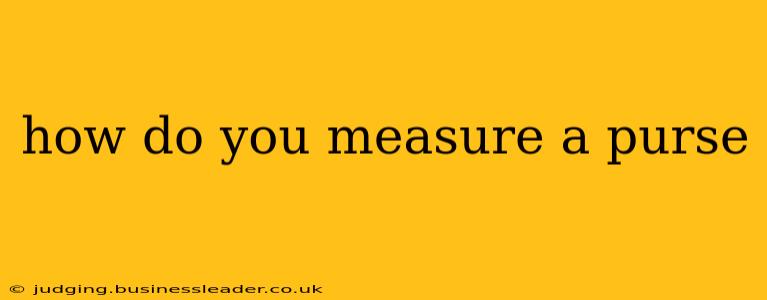Measuring a purse might seem straightforward, but getting accurate dimensions is crucial for online shopping, ensuring a proper fit for your needs, and even for reselling or storing your collection. This guide will walk you through the most effective ways to measure a purse, covering different shapes and addressing common questions.
What Tools Do I Need to Measure a Purse?
Before you begin, gather a few simple tools:
- A flexible measuring tape: This is essential for getting accurate measurements around curves. A fabric or retractable tape measure is ideal.
- A ruler or straight edge (optional): Helpful for measuring flat surfaces like the base of the bag.
- Pen and paper: To record your measurements.
- A helper (optional): For larger or awkwardly shaped purses, having an extra pair of hands can be beneficial.
How to Measure Different Purse Styles
The method for measuring your purse will depend slightly on its shape and features. Here's a breakdown for common styles:
Measuring a Tote Bag:
- Height: Measure from the top of the bag to the bottom, along the longest side.
- Width: Measure across the widest part of the bag at the top.
- Depth: Measure from the front to the back at the base of the bag.
- Handle Drop: Measure the length of the handle from where it attaches to the bag to the bottom of the handle. This is important for determining if the bag will sit comfortably on your shoulder or in your hand.
- Strap Length (if applicable): Measure the length of the shoulder strap from end to end.
Measuring a Shoulder Bag or Crossbody Bag:
The process is similar to measuring a tote bag, but you'll need to pay attention to the strap length and the bag's overall shape, which may be more structured or less voluminous than a tote.
- Height: Measure from the top to the bottom along the longest side.
- Width: Measure across the widest part of the bag.
- Depth: Measure from the front to the back.
- Strap Length: Measure the length of the strap from end to end, adjusted to your desired length.
Measuring a Clutch or Wallet-Style Purse:
These are generally easier to measure due to their simpler shapes.
- Length: Measure the longest side.
- Width: Measure the shortest side.
- Depth (if applicable): Measure the thickness of the purse.
How to Measure the Base of a Purse?
The base of a purse can be rectangular, circular, or even irregular. Use your ruler or measuring tape to measure the dimensions of the base accordingly. If the base is circular, measure the diameter. If it's rectangular or irregular, measure both the length and the width at the widest points.
What are the Standard Measurements of a Purse?
There aren't strict "standard" measurements for purses, as sizes vary greatly depending on the style and intended use. However, understanding the typical size ranges can help you when shopping or comparing purses. Small purses might measure 8" x 5" x 2", while larger totes can measure 15" x 12" x 6" or even larger.
How to Measure an Unusual Shaped Purse?
For unusually shaped purses, take multiple measurements along different axes to capture the overall size. Include notes in your measurements to describe the unusual shape and how you took the measurements. For example, you might note "widest point at top: 10 inches; base width: 8 inches."
Remember to always be as precise as possible when taking measurements. Accurate measurements will ensure a perfect fit for your needs.
By following these steps, you'll be able to accurately measure your purses and shop for new ones with confidence!
